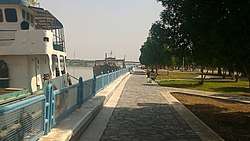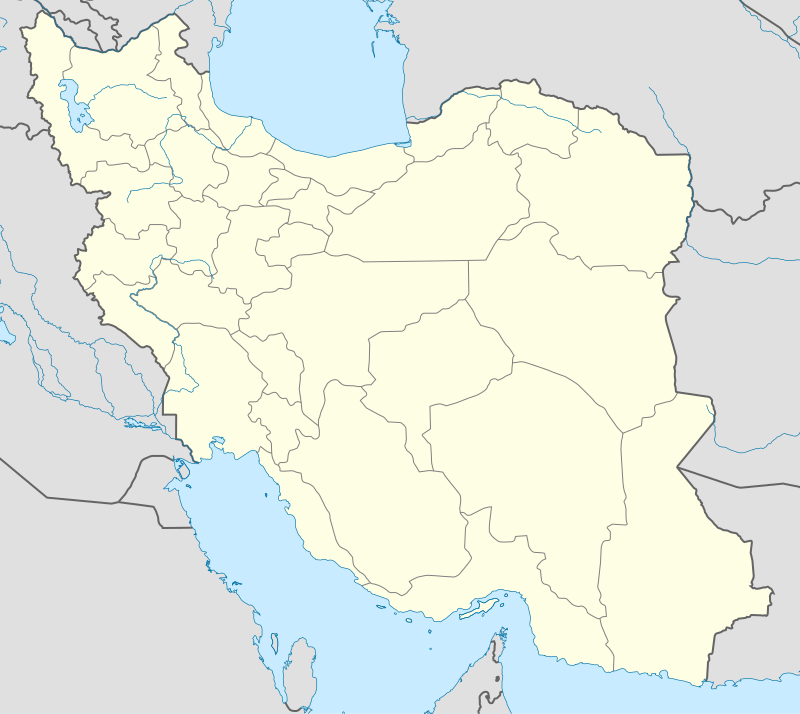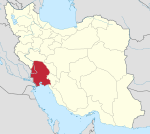Khorramshahr
Khorramshahr (Persian: خرمشهر [xoræmˈʃæhɾ], also romanized as Khurramshahr [1][2] is a city and capital of Khorramshahr County, Khuzestan Province, Iran. At the 2006 census, its population was 123,866, in 26,385 families.[3]
Khorramshahr خرَمشَهر | |
|---|---|
city | |
 | |
 Khorramshahr | |
| Coordinates: 30°26′23″N 48°09′59″E | |
| Country | |
| Province | Khuzestan |
| County | Khorramshahr |
| Bakhsh | Central |
| Population (2016 census) | |
| • Total | 133,097 |
| Time zone | UTC+3:30 (IRST) |
| • Summer (DST) | UTC+4:30 (IRDT) |
Khorramshahr is an inland port city located approximately 10 kilometres (6.2 mi) north of Abadan. The city extends to the right bank of the Shatt Al Arab waterway near its confluence with the Haffar arm of the Karun river. The 1986 census proved that as a result of the Iran-Iraq War, the city was poorly-populated. However more recent censuses show that the population has returned to its approximate pre-war level.
History
The area where the city exists today was originally under the waters of the Persian Gulf. It later became part of the vast marshlands and the tidal flats at the mouth of the Karun River. The small town known as Piyan, and later Bayan appeared in the area no sooner than the late Parthian time in the 1st. Century AD. Whether or not this was located at the same spot where Khurramshahr is today, is highly debatable.
During the Islamic centuries, the Daylamite Buwayhid king, Panah Khusraw Adud ad-Dawlah ordered the digging of a canal to join the Karun River (which at the time emptied independently into the Persian Gulf through the Bahmanshir channel) to the Shatt al-Arab (the joint estuary of the Tigris and Euphrates rivers, known in Iran as Arvand Rud). The extra water made the joint estuary more reliably navigable. The channel thus created was known as the Haffar, Arabic for "excavated," "dugout," which exactly described what the channel was. The Haffar soon became the main channel of the Karun, as it is in the present day.
Until 1847, at which time it became Persian territory (according to Article ii of the Treaty of Erzerum), Khorramshahr was alternately claimed and occupied by Persia and Turkey. Its ruler at the time was an Arab sheikh.[4]
In 1908, after seven years of searching, William D'Arcy got from his superiors one last chance to drill 1600 feet for oil. He found oil at about 1200 feet under the soil of Muhammerah and made a deal with the emir, Khaz'al bin Jabr bin Merdaw al-Ka'bi, who so became the first oil sheik and one of the richest leaders in the region at the time. The company of D'Arcy was a predecessor of BP. After Iran seized Mohammerah in 1921 emir Kha'zal was allowed to keep all his possessions, but got house arrest in Teheran.
The name of the town was changed to Khorramshahr following Reza Khan's rise to power.
Iran–Iraq War
During the Iran–Iraq War it was extensively ravaged by Iraqi forces as a result of Saddam Hussein's scorched earth policy. Prior to the war, Khorramshahr had grown extensively to become Iran's primary non-oil port city, and home to some of the most sprawling neighborhoods in Iran. The population was predominantly wealthy and upper class, and along with Abadan, the prevalent culture was that of modern Iranian cosmopolitanism.
The battle of Khorramshahr was the first major engagement between Iraqi and Iranians forces in the war. After occupying the city on October 26, the city remained in Iraqi hands until April 1982, when the Iranians launched Operation Beit ol-Moqaddas (Persian: بیت المقدس) to recapture the Khuzestan province. The first attack (April 30 to May 12) consisted of 70,000 Revolutionary Guard troops and succeeded in pushing the Iraqis out of the Ahvaz-Susangerd area. The Iraqis withdrew back to Khorramshahr and, on May 20, launched a large counter-attack against the Iranians, which was repulsed. The Iranians then launched an all-out assault on Khorramshahr, capturing two of the defense lines in the Pol-e No and Shalamcheh region. The Iranians gathered near the Shatt al-Arab (known as Arvand Rud in Iran) waterway, surrounding the city and, thus, beginning the second siege. The Iranians finally recaptured the city on May 24 after two days of bitter fighting and heavy losses, capturing 19,000 soldiers from a demoralized Iraqi Army after the fighting was over.. As a result, the Iraqis now know May 24 as “bad lucky Day”, although the Iranians celebrate the day as the Liberation of Khorramshahr.
By the end of the war, Khorramshahr had been completely devastated, with very few buildings left intact. Other major urban centres such as Abadan and Ahvaz were also left in ruins, though nowhere nearly as bad as Khorramshahr. The city of Khorramshahr was one of the primary and most important frontlines of the war and has thus achieved mythic status amongst the Iranian population. Because of the war, the population of Khorramshahr dropped from 146,706 in the 1976 census to 0 in the 1986 census. The population reached 34,750 in the 1991 census and by the 2006 census it reached 123,866, and according to World Gazetteer its population as of 2012 is 138,398, making the population close to what it was before the war.
Economy
The economy of Khorramshahr is still largely affected by the destruction and depopulation of the city's residents in the 1980s during the first years of the Iran–Iraq War. The main activities are, however, essentially the same as before the war, petroleum production and exports and imports through the city port, though on a much smaller scale as restoration is not yet totally complete, even though three decades have passed since the end of the war. Residents originally from Khorramshahr have also slowly been returning to the city, rebuilding their houses and businesses.
Climate
Khorramshahr has long, hot summers and mild, short winters. The mean temperature in summer is 42 degrees Celsius(108 Fahrenheit), maximum temperature in summer could soar up to 55 degrees Celsius (118 Fahrenheit) while in winters the minimum temperature could fall around 1 degrees Celsius(34 Fahrenheit). The annual rainfall is about 140 mm(5.5 inches). Khorramshahr experiences many sandstorms.
Marine Science & Technology University of Khorramshahr
In 1976, in Filieh, an area bordering the port city of Khorramshahr, the Persian Gulf Southern Branch of Jondi Shahpour University, Ahvaz (Shahid Chamran University), was established comprising two colleges: the College of Marine Sciences and the College of Maritime Management and Economics. But this newly established center was closed soon after due to the war imposed on Iran. This college recommenced academically in 1993, admitting 10 MS students in the fields of physical oceanography and marine biology on Shahid Chamran’s campus. With the start of the postwar reconstruction of the war torn cities of Abadan and Khorramshahr in 1998, the Southern Branch was moved back to Khorramshahr, expanding its academic scope by admitting undergraduate students in the fields of marine biology, environmental sciences and fisheries.
In 2003, this institute separated from Shahid Chamran University and became Khorramshahr University of Marine Science and Technology (KMSU), with access to open waters, the Shatt al-Arab and Bahmanshir rivers, and adjacency to the Shadegan and Hor Swamps, situated in the Arvand Free Zone.
Notable people
- Mohsen Rastani (b. 1958), photographer
References
- Khorramshahr can be found at GEOnet Names Server, at this link, by opening the Advanced Search box, entering "-3071225" in the "Unique Feature Id" form, and clicking on "Search Database".
- Khorramshahr entry in Encyclopædia Britannica http://www.britannica.com/EBchecked/topic/316878/Khorramshahr
- "Census of the Islamic Republic of Iran, 1385 (2006)". Islamic Republic of Iran. Archived from the original (Excel) on 2011-11-11.
-

